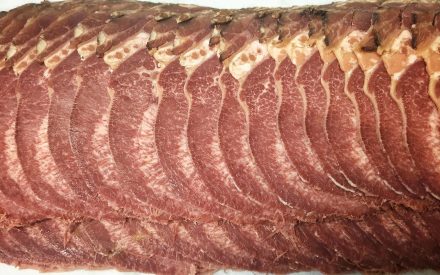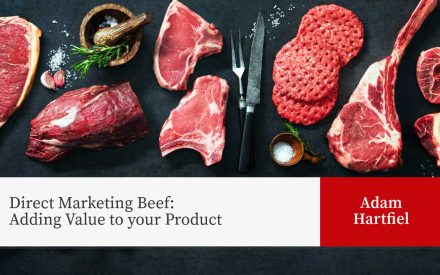University of Wisconsin Recall Plan
A recall is an effective method of removing from commerce any product that may be adulterated or misbranded. Firms such as a manufacturer, distributor, or importer, take these actions as part of their responsibility to protect the public health and welfare.
A recall can be disruptive to a firm’s operation and business; however, there are several steps that a firm can take to minimize this disruption. An operator of an inspected establishment should take measures that will ensure rapid and effective response if products that appear to be adulterated have entered commerce. The operator should prepare and maintain a detailed, written recall plan. This plan should describe, step by step, the procedures the firm will follow in case it becomes necessary to recall a product. The UW Model Recall Plan can serve as a guide in developing a business’ recall plan.
Restricted Ingredient Calculations
A helpful tool for meat processors in the development of processed products.
***Cure accelerators or phosphates can be substituted for nitrite in below equations***
Sodium Nitrite – Comminuted
ppm in product = (lb. nitrite)(1,000,000)
green weight of meat block
lbs. of sodium nitrite to add = (ppm / 1,000,000)(meat block)
Sodium Nitrite – Injection
ppm in product = (lb. nitrite)(% injection)(1,000,000)
total lbs. of brine
lbs. of sodium nitrite to add = [(ppm / 1,000,000)(total lbs. of brine)] / % injection
Curing Salt (6.25% sodium nitrite) – Comminuted
ppm in product = (lb. curing salt)(0.0625)(1,000,000)
green weight of meat block
lbs. of curing salt to add = [(ppm / 1,000,000)(meat block)] / 0.0625
Curing Salt (6.25% sodium nitrite) – Injection
ppm in product = [(lbs. of curing salt)(0.0625)(% injection)(1,000,000)]
lbs. of total brine
lbs. of curing salt to add = ppm / 1,000,000 = X
% injection
[( X )(lbs. of total brine)] / .0625
Wisconsin’s State Meat Inspection Program
Cleanliness. Wholesomeness. Safety. These are the standards of quality found in State of Wisconsin-inspected meat plants and products. The State of Wisconsin meat inspection program and meat establishments ensure that meat products produced in the state and sold to consumers comply with required standards for safety, purity and wholesomeness set by the state and federal governments. In fact, all products produced in a state-inspected plant must meet or exceed standards set by the U.S. Department of Agriculture.
Food Standards and Labeling Policy Book
This Policy Book is assembled in dictionary form and may be used in conjunction with the Meat and Poultry Inspection Regulations and the Meat and Poultry Inspection Manual, Directives and Notices. It is a composite of policy and day-to-day labeling decision, many of which do not appear in the above publications. They are subject to change and therefore a periodic updating of this book will take place.
Processing Inspectors Calculations Handbook
The mission of the Food Safety and Inspection Service (FSIS) is to assure that meat, meat food, poultry, and poultry food products distributed in interstate commerce are wholesome, not adulterated, and properly marked, labeled, and packaged. FSIS enforces the Federal Meat Inspection Act (FMIA), the Poultry Products Inspection Act (PPIA), and the regulations implementing these laws. Documents such as the FSIS Directives, FSIS Notices, and the Meat and Poultry Inspection (MPI) Manual provide inspection personnel with specific instructions and policies to help them enforce the laws and regulations. Whether meat and poultry products are in compliance with the laws and regulations is often determined by how the products are formulated and processed. Careful attention to the kind and amount of ingredients, their conditions of use, and the standards of product identity and composition are necessary to assure compliance.
The Processing Inspectors’ Calculations Handbook is intended primarily as a reference or aid to learning how to perform various calculations. It should also help provide insight into the reason why a given policy is needed and its relative importance in a science-based food safety program.
Good Manufacturing Practices for Fermented Dry & Semi-Dry Sausage Products
GMPs are programs that comprise the basic, universal steps and procedures that control operating conditions within establishments and ensure favorable conditions for the production of safe food. HACCP systems relate to hazards within a specific process. GMPs are the control factors that relate to the entire operation and are not process-specific. GMPs include such programs as pest control, recall procedures, construction/maintenance and sanitation.
This document is intended to provide the Good Manufacturing Practices (GMPs) for dry and semidry sausages. Special attention is directed toward the microbiological condition of the products given the emphasis currently placed on the microbiological quality and safety of processed meats. In 1997, FSIS initiated intensified and expanded microbiological testing of dry and semi-dry fermented sausages for E. coli O157:H7, Listeria sp., Salmonella sp. and Staphylococcus aureus; testing requirements are part of the GMPs.


 Bird Breakdown: Exploring Yields and Cuts of Poultry
Bird Breakdown: Exploring Yields and Cuts of Poultry Starting a Meat Business in Wisconsin
Starting a Meat Business in Wisconsin Importance of Forage Growth Stages When Grazing Cattle
Importance of Forage Growth Stages When Grazing Cattle Direct Marketing Beef: Adding Value to your Product
Direct Marketing Beef: Adding Value to your Product 


